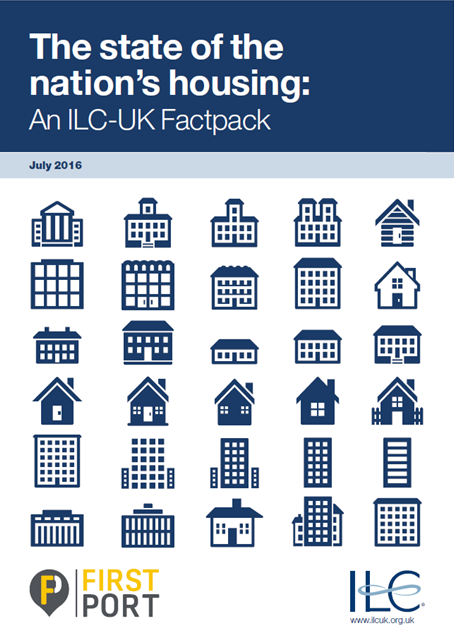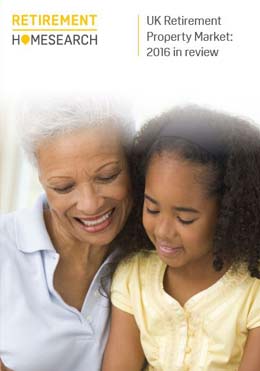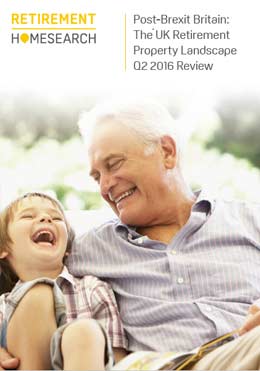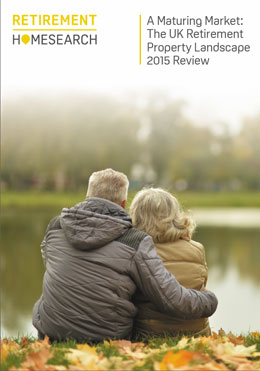December 2017 - Survey shows vast gulf between demand and supply in retirement housing
A survey conducted by YouGov on behalf of Retirement Homesearch shows that 19% of UK over-50s believe it is ‘likely’ that they will spend their autumn years in a purpose-built retirement community.
Yet such housing comprises just 2% of existing housing stock – meaning that a vast demand remains unfulfilled.
1,000 over-50s were asked first whether they were likely to move into a specialist retirement community, and then what factors were most important to them in deciding where to live in retirement.
If the results are taken as representative of the UK over-50s population, it would mean 4.5 million people competing for around 500,000 retirement homes.
Retirement Homesearch Managing Director, Nick Freeth, said:
“We were looking to take a snapshot of changing priorities in choosing retirement living arrangements. The expectation is that a ‘new generation’ of retirees anticipate a more active retirement, that we are increasingly seeking entertainment and healthy activity over the community-centred life that so appealed to earlier retirees.
“This isn’t exactly the picture that comes out of our results. It looks very much as though there is a problem of public perception – many say they don’t want to move to a specialist retirement community, and those who tell us that they are interested in doing so are concerned that they should live amongst some diversity.
“This suggests that the public still don’t understand the market offering. The image they have in their heads is of the old warden-controlled ‘old people’s homes’. Modern retirement living is a far cry from that.
“But overwhelmingly, the message from this survey is that, despite any image problem, there is far, far more demand for retirement living than the market can satisfy. There is good reason to believe that this will hold true and that it means a very strong future for the retirement housing market.”
The survey was undertaken in partnership with the International Longevity Centre UK (ILC-UK).
The ILC-UK’s Dr Brian Beach said:
“It would be over-simplistic to suggest that the housing crisis could be resolved just through older people downsizing to make homes available for younger households – but the retirement housing market does play a role.
“This survey confirms that demand in the UK greatly outstrips supply and gives stakeholders in this market an idea of where priorities might best be focused to serve older consumers.
“At the same time, the survey shows that there is work to do to raise awareness around retirement, as we can see persisting inaccurate stereotypes and a disconnect between what people want from retirement compared to what they are likely to need.”
Click here to view the Quarter 3 2017 review.
August 2017 - ‘Proceedable’ buyers in retirement could be boosted by financial changes for tomorrow’s pensioners
Leading specialist retirement estate agency, Retirement Homesearch (RHS) predicts that changes to pensioners’ financial outlook may impact the number of new buyers entering the market.
Highlighting changes such as the future planned increase in the state pension age and the review of the “triple lock”, RHS say these factors may give a boost to the market as people will have to consider downsizing to free up assets.
Retirement Homesearch’s Quarter 2, 2017 review highlights the importance of ‘proceedable’ buyers in the retirement market as a ‘critical factor’ that could be impacted by the changing financial landscape for tomorrow’s pensioners.
Retirement Homesearch is seeing a very small rise on last year for new instructions and current stock levels. This is at odds with the open market picture, which shows the supply of new stock falling for the 16th month in a row.1 Whilst the modest increase in retirement stock is encouraging, the availability of proceedable buyers is key.
Nick Freeth, Managing Director of Retirement Homesearch highlights: “In the retirement market new stock levels are more steady but the availability of proceedable buyers is a more critical factor and will continue to be a key focus for the market.”
Nick adds: “The changes afoot may well give a boost to the market as people have to seriously consider freeing up some of their assets and downsize – for example, it’s predicted that there will be more financial hardship - particularly for women - who will have to wait longer than expected to draw their state pension.”
Ian Price, Retirement Proposition Divisional Director at St. James’s Place Wealth Management, adds: “Releasing cash to fund retirement by downsizing the family home is often a highly emotional time, but is a path well-trodden by retirees in the UK. In these times, where inflation rates are out-pacing returns on cash in the bank and we are all living longer, your money needs to go further, so reviewing your financial and estate planning needs for retirement makes good sense.“
Changes in the financial landscape may mean that a typical dweller of a retirement property may change with an increase of ‘working residents’, and this Quarter’s review interviews four working residents. Ivy Brownlie, is 85 and works at a local Doctors’ surgery. She says: “I can’t afford to retire just yet! Our development is for people who want to live independently so suits my working lifestyle. Some (residents) do raise an eyebrow when I tell them I can’t attend a social event because I have to go to work!”
1 The latest RICS UK Residential Market Survey shows the supply of new stock falling for the 16th month in a row.
Click here to view the Quarter 2, 2017 review.
May 2017 - The calm before the storm?
The UK’s leading retirement property specialist releases its latest quarterly review of the UK market and beyond.
The review highlights retirement property enquiries on the up, with a 17% increase in new registrations for the first quarter of 2017 compared to the same period last year, showing a resilient ‘bounce’ after a quiet final quarter of 2016.
However, as we all eagerly wait to see what happens here in the UK- particularly with the snap election now on the table for June - and we know that the property market doesn’t like uncertainty - this quarter’s edition looks at retirement living in other parts of the world. An aging demographic is common in many countries but the approaches to retirement are not. Maybe we, in the UK, can take some ideas from neighbours near and far.
Nick Freeth, Retirement Homesearch Managing Director, said:
“Approaches to retirement living vary significantly around the world. Whether this is Spain’s older population whose tradition is to stay at home with family, or Australia’s, who are so accustomed to apartment living that their market is seeing a demand in high rise retirement blocks.
“One common theme that runs throughout is the need for retirement markets around the world to respond to changing demographics. Here in the UK, the supply of retirement housing needs to increase five-fold to match the aging and growing population. We’re calling for Government to react by going further to incentivise developers to build these much-needed homes and to incentivise last-time buyers by making downsizing more attractive, through options like stamp duty holidays and a smoother buying process.”
Click here to view the Quarter 1 2017 review.
30/01/17 - Call to encourage Last-Time Buyer movement as Britons put off downsizing
New research conducted by Retirement Homesearch has revealed a gap between the age people imagine they will downsize and the reality, with data showing that the age UK adults expect to downsize or move into a specialist retirement property increases as they get older.
Whilst the UK’s younger generation sees themselves moving into a retirement property at the mean age of 65, Briton’s aged between 55-64 year-olds say this won’t happen until they’re 70 with only 6% of over 65s surveyed having already downsized or moved to a specialist home.
The top reasons given for this inertia were finding the right property (48%), having to get rid of excess belongings (36%) and the emotional strain of leaving a family home (34%). Those surveyed were also asked what their most important factors were when choosing a new home to downsize to which showed that being close to family and amenities was the top reason (40%), with an easy to run, modern apartment as second (27%).
These results also seemed to vary with age, with an easy-to-run, modern apartment as one of the most important factors for those aged 65+ at 34%, but less important for 18-24 year-olds at only 21%, showing a shift of priorities as we're getting older.
Nick Freeth, Managing Director, Retirement Homesearch says: “What the data clearly shows is that navigating through the retirement property market to find a home that is right for you is hard, especially when added on top of the stress that moving property already brings.
Efforts to pay more attention to the factors which are important to people looking to downsize and increase the amount of specialist retirement properties on offer could go a long way to ease the pressure Britons are faced with when making this decision.
What’s more, our latest quarterly review figures show the knock on effects of last year’s political turmoil and economic uncertainty with new buyer registrations down 25% and sales down 4% compared to the previous year. As the UK is now faced with housing shortages and under-occupied family homes it is more important than ever before that we encourage the ‘last-time buyer’ movement and incentivise the older generation to take the leap.”
Click here to view the Quarter 4 2016 review.
20/07/16 - The state of the nation's housing: An ILC-UK Factpack
Significant increase in older people living alone, but millions are failing to adapt their homes to help them live independently
- Growing numbers of 45-64 year olds, and 65-74 year olds are living alone, with 6 million people living in houses with two or more excess bedrooms.
- Think Tank urges government action on supply whilst also calling for more support to encourage people to adapt their own homes.
- New analysis for ‘The State of the Nation’s Housing’ projects a shortage of 160,000 retirement housing by 2030.
Despite significant increases in the numbers of older people living alone, half of all older people with care needs haven’t made adaptations to their homes to make it easier to live in, finds the International Longevity Centre – UK (ILC-UK) in their new “State of the Nation’s Housing” report.
Whilst specialist retirement housing can offer more adaptations and play a part in supporting downsizing, new analysis from the think tank finds that the retirement housing supply gap is set to worsen.
The State of the Nation’s Housing is published today by the International Longevity Centre – UK (ILC-UK), and supported by FirstPort, the UK’s largest residential property manager. The report paints a picture of increased under occupancy and declining average household size:
- Since 2005 there has been a significant increase in the number of 45-64 year olds living alone (500,000) as well as the number of 65-74 year olds living alone (300,000).
- The average household size was 2.9 people in 1971. Today there are on average 2.3 people per household.
- Over 16 million people – mainly owner occupied, middle aged and older households - live in under-occupied housing. 6 million live in houses with 2 or more excess bedrooms.
- The 50 to 64 age group has the highest number of people in under-occupied homes (4.5 million), while the 65-79 age group has the highest proportion.
- Nearly 9 in 10 of the 65-79 age group live in under-occupied housing – over 50% live in homes with two or more excess bedrooms.
But millions of over 50s with care needs haven’t adapted their housing
- Population ageing is leading to rising care needs, but these needs are not being met. Since 2008-9 the numbers of older people (aged over 65) receiving care has fallen by 30%, while it has fallen by around 26% for those aged 18-64. As a result there are now half a million fewer people receiving care services than there were in 2008-9.
- In 2012/13, there were 1.86 million people over the age of 50 in England who had unmet needs – an increase of 120,000 people (or 7%) since 2006/7. This means that around 1 in 10 people aged over 50 in England has an unmet care need.
- Less than half of those over 50s with a limitation in an Activity of Daily Living (ADL) live in homes with any health-related adaptations.
Specialist retirement housing could be a solution for some, but new analysis by the ILC-UK projects a shortage of 160,000 retirement housing by 2030
- Those in retirement housing are significantly more likely to be living in homes with adaptations than those who do not. Approximately 87% of those in retirement housing have home adaptations, by comparison to around 60% of other housing.
- The rate of construction of new housing for older people has varied over the years. It peaked in 1989 at 30,000 units but has since fallen back dramatically – averaging around 7,000 new units a year over the last decade.
- There are around 515,000 specialist retirement and extra care homes in England. However, this means that there is only enough specialist housing to accommodate 5% of the over-65 population.
- According to our calculations, there could be a retirement housing gap of 160,000 retirement housing by 2030 if current trends continue. By 2050, the gap could grow to 376,000.
- Among those over 50 who reported having problems with their homes, the most common noise (around 25%) and being too cold in the winter (around 20%).
Baroness Sally Greengross, Chief Executive, ILC-UK said:
"Our report highlights that there are millions of over 50s with care needs who haven’t adapted their housing for old age and may be in homes too big for them.
"Retirement housing could be a solution for some older people but we are building far too few of this type of housing.
"Government must ensure that planning better supports and encourages adaptations. If older people are to live longer in their own homes we must better support older people to make adaptations to allow them to continue to live independently their own homes. A freeze in the current rate of stamp duty might also encourage more over 50s to move to homes better suited to their current, and future needs."
Nigel Howell, Chief Executive, FirstPort, said:
"As an industry, we need to make downsizing work better in order to reduce under-occupancy and ensure people are living in properties suited to their needs. Perhaps there needs to be a more flexible model than we have traditionally seen in the UK where home-ownership is seen as the ultimate aim for many. With today's varied lifestyles, apartment living can be a very attractive home option at any age, whether owned or rented. One beauty of apartment living for older customers is the combination of having your own home yet with the social infrastructure that comes with an apartment lifestyle.
"We aim to continue working with partners in the property sector to drive forward these issues and present possible incentives and solutions so people can live in the properties that suit their lifestyle. Alongside this, we will help to inform the debate to ensure that we do not forget the real people behind these issues.”
To produce The State of the Nation’s Housing, ILC-UK has analysed data available through wave 7 of the The English Longitudinal Study of Ageing and data from the English Housing Survey. The report also incorporates analysis of other official data sets including those produced by ONS and Government Departments.
Notes to Editors
Full references are available in The State of the Nation’s Housing. To produce The State of the Nation’s Housing, ILC-UK has analysed data available through wave 7 of the The English Longitudinal Study of Ageing and data from the English Housing Survey. The report also incorporates analysis of other official data sets including those produced by ONS and Government Departments.
The State of the Nation’s Housing will be published on the ILC-UK website on 19th July 2016. Click here to download the report.
The International Longevity Centre – UK (ILC-UK) is a futures organisation focussed on some of the biggest challenges facing Government and society in the context of demographic change.
19/11/15 - Advice & opinion Downsizing
Bigger isn’t always better
We must support – not shame – older homeowners into downsizing, says Nick Freeth

Retirement downsizing has moved up the property market agenda in the past few weeks, following the recent, controversial comments from Lynda Blackwell, head of mortgages at the Financial Conduct Authority. Lynda believes that the Government should do more to encourage older homeowners “sitting happily in big houses” to downsize and free up family homes, alleviating the current UK housing crisis.
This has sparked fierce debate over the way we view and treat ‘last time buyers’, with various industry commentators weighing in, including Saga and RICS. The former argued that the comments were ‘unhelpful’ and ‘insulting’, while the latter released research last week which showed that encouraging older homeowners to move into smaller houses could free up £820 billion in property assets, or 2.6 million family homes.
It is clear this debate is as emotive as it is economic. Faced with the facts, few could argue that there isn’t a genuine blockage at the top of the market and perhaps the Government’s emphasis should be shifted from first-time buyers to last-time buyers to solve the country’s housing issues. But this shift must be handled with the proper consideration and sensitivity it merits.
In our experience, downsizing is driven by retirees who want security, safety, convenience and companionship in their later years. Rather than forcing, bullying or blaming ‘home blockers’, in order to free up large family homes for the benefit of people who want to live in them, we need to present downsizing as the positive and exciting opportunity it should be.
So it is vitally important that, as part of this debate, we address the human side of the issue.
For anyone who has gone through it, buying and selling a home is a large undertaking. Often complex and undoubtedly time-consuming, it can be especially traumatic for older homeowners, who may have lived in their family home for decades, raised their children in them and can be reluctant to upend their lives and memories. My own elderly mother is a case in point. She lives in a house that is far too big for her on her own, yet she is so daunted by the prospect of downsizing that she probably never will get round to it.
These are just some of the issues we need to address. With over 25 years of experience in the retirement property market, dealing with around 2,500 enquiries each month, we know that in order to make downsizing work, it is crucial to offer empathy and a way forward that suits last-time buyers just as much as first-time buyers. We must make the transition as seamless and easy as possible for older homeowners. Recently, we have seen our part- exchange service becoming increasingly popular among sellers who are looking for a quick and less stressful transaction. This involves exchanging a percentage of the property’s equity for a guaranteed sale within a set time frame, taking away the possibility of collapsed chains.
Yet, we understand that getting the emotional response right is only one part of the puzzle. As the debate rumbles on, there will be serious questions that need to be answered around other issues to do with downsizing. Research by Saga shows that while two-thirds of older homeowners would consider moving home in retirement, they feel unable to do so – either because there are not enough appropriate properties to move to, or because the costs involved far outweigh any benefit.
Cost and availability of stock are two fundamental – not to mention, complex – concerns that need to be addressed. We can produce all the emotional support in the world, but if there are not the right financial incentives in place to support older people to move or the right regulations for retirement home developments to boost stock, this will all be in vain.
While there are no quick-fix answers to these questions, industry figures and policymakers should look into incentives for homeowners and property developers in more detail. With our background in this area, we have a couple of initial thoughts but would welcome further debate and discussion.
For instance, in terms of financial incentives for homeowners, could we consider a special ISA saving product where older homeowners can store freed-up equity resulting from the sale of their home? Can we waive stamp duty on onward, downsized purchases or ring fence released equity against inheritance tax? The latter has, in part, been addressed in the last Budget but is capped at £175,000.
Answering the housing stock question is less simple. Building appropriate retirement properties is the first step, as the UK lags well behind other countries on this front. In the United States, retirement housing accounts for 17% of housing stock; in Australia it accounts for 13%, whereas retirement properties (either as apartments within purpose built sites, retirement villages, or smaller bespoke developments) make up just 2% of the UK’s private housing stock.
With the UK facing the prospect of an ageing population and a worsening housing crisis, do we need to start discussions about how planning regulations for retirement home developers could be relaxed in order to boost this much-needed housing stock?
As an industry, we need to further this dialogue in order to make downsizing work better. From our side, Retirement Homesearch will be working with its partners in the retirement property sector to drive forward these issues and present possible incentives and solutions. Alongside this, we will help to inform the debate to ensure that we do not forget the real people behind these issues.
After all, if we are to truly shift perceptions around downsizing and make it work for last-time buyers, as well as first-time buyers, we must fundamentally change the tone of this debate to focus on people and their needs – not property assets or housing stock.
The Downsized View
Mary Platt, 88, lives in a one-bedroom flat in Highview Court, an assisted-living retirement development in Christchurch, Dorset.
Made up of 55 flats, Highview Court was built in 2008 and is managed by FirstPort. The development is located close to the beaches of Highcliffe, as well as a doctor’s surgery, shops and a park, while the assisted living approach involves 24 hour on-site staff, a restaurant providing one three-course meal a day and laundry service.
Mary, along with the development’s other residents, has access to a number of weekly social activities, including Pilates, cards and games afternoons, a film club, indoor bowls and cream teas. There is also a theatre group, which goes off site to attend local productions, and a monthly Holy Communion service, overseen by a visiting vicar.
In spite of the vibrant social scene, downsizing wasn’t front of mind for Mary before she moved in, but after a speculative visit, she changed her mind. “When I first came here to view the development, I had no intention to buy,” Mary confirms, “but after visiting I thought that this would suit me perfectly.”
Mary speaks about the “positive attitude” among the other residents and the “peace of mind” given to her by the managed properties, although she admits that assisted-living is not for everyone, with some people her age not wanting it and others being better suited to a care home where they receive more practical and physical support.
Despite this, Highview Court is home to two centenarians, “so we must be doing something right,” another resident notes.
Nick Freeth is Managing Director of Retirement Homesearch
Retirement Homesearch’s Nick Freeth does “downsizing” down to a tee…
Retirement Homesearch’s Nick Freeth does “downsizing” down to a tee…

Nick Freeth, Managing Director of Retirement Homesearch, the UK’s largest specialist retirement property agents, gives his thoughts and tips on how best to downsize. As the UK faces a housing crisis, this could be helped if more retirees downsized into a home suited to their needs.
The first step to downsizing your family home however, is to get the emotions right. Look upon “downsizing” as an exciting opportunity, a beginning to a new phase of your life, not negative one. Moving to a smaller, easier to maintain property will not only free up your time, but also has many positive financial impacts.
When it comes to downsizing, don’t try to do everything on your own. For many people, part of the decision to downsize is motivated by a desire not to be “a burden” on friends and family. That is fine, but this is one occasion when you are entirely justified in seeking the assistance of others, after all, moving house can be one of the most stressful events and no one should do it alone. However, if you are uncomfortable with asking members of your friends and families, know that there are specialist individuals and firms who can help, if you would rather pay.
For those worried that ‘downsizing’ to a smaller property (maybe one bedroom) may prevent family and friends coming to visit, it’s worth bearing in mind many developments have “Guest Suites” for visitors to stay overnight.
Also, if you are moving to a “retirement” development there may well be a “social” aspect to living there. Engage with it, don’t isolate yourself and be lonely. Embrace your new surroundings and make the most of the facilities in your area.
Here are some practical tips to help smooth the move
- Plan, plan and then plan again. One aspect of downsizing is deciding what to take. Don’t leave this to the last minute. It’s a great opportunity to pass cherished but too large or no longer needed items on to friends and family (but don’t be offended if they say “no thanks”)
- If you’re not sure whether something is for keeping, consider renting/borrowing some short term storage. Then you can move and better assess if something is “indispensable” and retrieve it
- Sort out utilities etc. well in advance. New phone lines, broadband etc. can sometimes take weeks to sort out
- Check that any furniture you’re planning to take with you will fit in your new home
- It’s good to get to know your new home and neighbours before you move. Visit the development a few times and if there’s an onsite manager (sometimes called a House, Development or Lodge Manager) get to know them and ask if they could make a few introductions for you
Downsizing is a practical endeavour with huge emotional impact and potential benefits. Get it right and you could give yourself a new lease of life. Many residents of retirement homes that I speak with say they wish they had made the move sooner so make the most of it. Don’t leave it until circumstances force you to act.
Nick Freeth is Managing Director of Retirement Homesearch


















